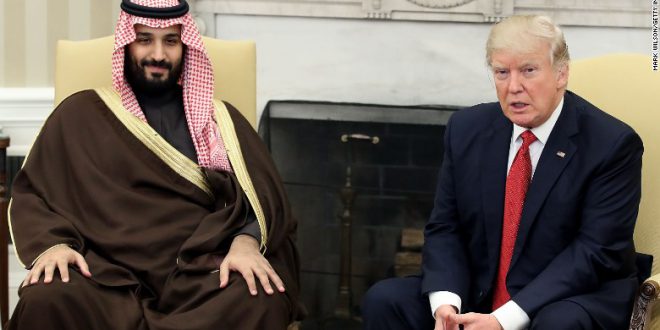The Trump administration has sent a request to Saudi Arabia for it and the rest of OPEC to boost oil production by 1 million barrels per day (mb d). according to a Bloomberg report.
It wasn’t the first time that the U.S. has asked Saudi Arabia to ratchet up supply in an effort to relieve high prices. Former President George W. Bush pressed the Saudis to increase output in early 2008. just ahead of the historic run up in prices. His pleas. which persisted in the first half of the year as oil prices continued to rise. were rebuffed by Saudi Arabia. A few months later. the financial crisis helped resolve the problem of expensive oil.
In 2012. the Obama administration asked Saudi Arabia to increase production after an international coalition slapped sanctions on Iran. which cut down Iranian oil exports by about 1 mb d.
Now. the U.S. finds itself in a similar situation as it did six years ago. Oil prices climbed to multi-year highs and sanctions on Iran threaten to push prices even higher. However. what is a bit more unusual from the U.S. government’s request this time around is the Trump administration apparently has a specific figure in mind – the Saudis and OPEC should increase output by 1 mb d. the U.S. said. according to Bloomberg. To be sure. Reuters reported that the U.S. did not request a specific figure.
Either way. in a departure from the past. OPEC seems to be more amenable to American appeals for higher output. The cartel’s Secretary-General said a few weeks ago that the tweet from President Trump in April influenced their calculations. and they felt they needed to prevent prices from rising too much.
And comments from Secretary of Treasury Steven Mnuchin in May suggested that the U.S. and Saudi Arabia had at least discussed the possibility in the context of the U.S. pulling out of the Iran nuclear deal. Mnuchin said that `various conversations with various parties about different parties that would be willing to increase oil supply to offset` the losses of Iranian supply. A bit of a word salad. but Mnuchin was likely telegraphing the willingness of Saudi Arabia to increase supply.
OPEC officials huddled in Kuwait just a few days ago. trying to hash out a strategy ahead of the June 22 meeting. OPEC officials were tight-lipped about what was discussed. but they promised to “ensure stable oil supplies are made available in a timely manner to meet growing demand and offset declines in some parts of the world.“ The boilerplate statement could be interpreted as a willingness to increase output this year. ahead of schedule. but it was likely intentional that the statement was left so vague.
Despite all the jockeying behind closed doors. a series of public comments from the Saudi and Russian energy ministers suggest that the two largest producers in the OPEC+ group will likely agree to increase production in two weeks’ time. although the specifics still need to be hammered out. Russia is aiming for a larger increase in supply. perhaps around 1 mb d. Saudi Arabia wants something much more modest.
There are a few reasons why OPEC might be more sensitive to the wishes of the U.S. government than they were in the past. For one. the Trump administration has been very explicit about its support for Riyadh. and hasn’t expressed any concern about human rights. or the war in Yemen. or other issues that might irk the Saudi government. Trump is also much more aggressive towards Iran than the Obama administration. something that goes down well with the Saudi regime.
Moreover. the Saudi government. led by crown prince Mohammed bin Salman. is more bellicose than it used to be. MbS. as he is known. has waged an aggressive foreign policy. and is itching for a fight with Iran. The Saudis need the U.S. on board with that campaign. so placating Washington with cheaper gasoline prices is a small price to pay.
However. unlike the past. the biggest difference arguably comes from the oil market itself. A decade ago. when President Bush asked for help. Saudi Arabia saw little downside in snubbing him. The U.S. was hopelessly addicted to oil. and had no way to avoid paying high prices. While that addiction has changed only marginally in the intervening years. the difference between then and now is that Saudi Arabia has to worry about losing market share to U.S. shale drillers.
The “Saudi vs. U.S. shale“ narrative is a bit overblown in the media. but the fact of the matter is that OPEC runs the risk of sparking too much high-cost supply if it lets prices rise too far. In years past. $100 oil would stimulate new investment. but those projects would take years to come online. Short lead times for shale. however. have sped up the price cycles. so the risk is that high prices will lead to a wave of new supply. which crash prices again in short order. Indeed. U.S. shale has already grown rapidly over the past few quarters.
In short. Saudi Arabia looks ready to increase production. but it has a variety of reasons why it could agree to do so. It isn’t just that Riyadh is complying with a specific demand from the U.S. government.
 Iran Energy News Oil, Gas, Petrochemical and Energy Field Specialized Channel
Iran Energy News Oil, Gas, Petrochemical and Energy Field Specialized Channel




